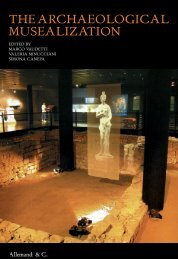RELIGION AND MUSEUMS - Allemandi
RELIGION AND MUSEUMS - Allemandi
RELIGION AND MUSEUMS - Allemandi
Create successful ePaper yourself
Turn your PDF publications into a flip-book with our unique Google optimized e-Paper software.
produced in projects enabled by finance chiefly from the Swedish Arts Council andthe Bank of Sweden Tercentenary Foundation, illuminating and problematizing theacquisition contexts of the collected objects and their new roles in the present day. Thisfield is reflected in titles from the museum’s publications, such as Med världen i kappsäcken(With the World in the Suitcase, Östberg 2002), Förfärliga och begärliga föremål (Dreadfuland Desirable Objects, Gustafsson Reinius 2005, for an English version cf. 2011a),Mänskliga kvarlevor (Human Remains, Hallgren 2010), and Vem tillhör föremålen? (WhoOwns the Objects?, Östberg 2010).Also belonging to this context is my own project, financed by the Swedish ResearchCouncil, “Rituals of Reconciliation in the Post-secular Museum” which deals withrestoration matters from a ritual perspective. This in turn is part of the research programme“The Socio-material Dynamics of Museum Collections” (GustafssonReinius, Silvén, Svanberg 2012), which also includes ongoing studies of shifts andwatersheds in the handling of remains (Fredrik Svanberg) and Sami collections (EvaSilvén) at the Nordic Museum, the Historical Museum and the Museum of Ethnography.5 The discussion of difficult objects and acquisition contexts, and of the meaning-makingroles of museum practice, is linked to the growing international researchfield of new museology (Vergo 1989; Karp, Lavine 1991; Lavine 2006) and not leastto the critique of representation expressed there about museums of ethnography (e.g.Ames 1992; Kirshenblatt-Gimblett 1998; Edwards, Gosden, Phillips 2006).A methodological gain from the research project is its model for integrating external researchperspectives in the museum’s internal discussion. On-going studies and exhibitionprojects were able to derive examples and energy from each other’s thinking andproblem-solving. The way this happened in concrete terms was that a group consistingof all the museum’s curators, educators, exhibition staff, and the librarian, together withthe two external researchers, took part in a year-long series of seminars and excursions,conducted by the undersigned project leader. To link up with an international discussion,a multidisciplinary workshop was held at the Museum of Ethnography on 5-6 May2011: “Secular Frames and Sacred Matter in the Post-secular Society”. Besides the invitedspeakers Christopher Wingfield, John Cussans, Annette Rein, and ChristianSchicklgruber, twenty or so specially invited research and museum people took part.Last but not least, “Sacred Things in the Post-secular Society” has provided ideas fortwo exhibitions: the travelling exhibition “Vodou” (pl. 1), in the version shown at theMuseum of Ethnography in the spring of 2011, and a forthcoming permanent exhibitionwith the working title “World Religions?” preliminarily planned for 2015.41







